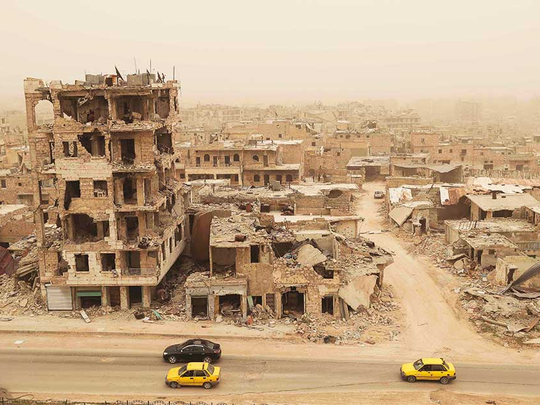
Aleppo: When the army recaptured Aleppo in December, it was the final nail in the coffin of Syrian rebel dreams of toppling the regime.
Syria’s war erupted on March 15, 2011 with peaceful demonstrations that, after a violent crackdown by government security forces, transformed into an armed uprising.
In six years, the multi-front war has become one of the most destructive conflicts of the 21st century.
Backed by Turkey, the Gulf and some Western nations, Syrian rebels were at their strongest in 2012 and many thought they would march to Damascus.
But Al Assad’s powerful allies came to the rescue: Iran sent military advisers and fighters, Lebanon’s Shiite militant group Hezbollah joined forces and Russia began a deadly bombing campaign in support of Damascus in 2015.
That support was key to retaking Aleppo, allowing the government to consolidate its upper hand by seizing other strategic territory, including from Daesh in northern Syria.
While swathes of the country remain embroiled in violence, Syria’s government has decidedly won the crux of the conflict.
Aleppo, meanwhile, has become a symbol of the most destructive streak of the war and its residents are just desperate for some respite.
“I think the war is heading toward an end, because people are tired and they prefer to stay where they are instead of being displaced again,” said Ebrahim Amoura, a 35-year-old labourer.
He spoke to AFP while working on a ceiling in the formerly rebel-held district of Karm Al Jabal.
For years, residents of Karm Al Jabal had only heard the sounds of gunfire and bombardment. Now, the nearly-incessant whirring of generators, cement mixers and pounding hammers fill their days.
A larger-than-life portrait of Al Assad with Russian President Vladimir Putin in the background looks over what was once Aleppo’s front line, teeming with military vehicles and Russian soldiers.
The municipality is eager to erase all trace of the former fault line that split the city for years between the government-held west and rebel-controlled east.
But the divide is powerful: buildings in the west were indeed damaged by rebel rockets, but the east has been totally ravaged, reduced to rows of crumbling buildings nearly indistinguishable from each other.
State electricity is equally rare, and generators are cropping up across the city.
For rebels living just outside the city, Aleppo’s fall was indeed a turning point - but instead of a harbinger of stability, it was a death knell for their dreams of Al Assad’s ouster.
“Aleppo was the mother of all revolutionaries. Losing her really was like losing our mother,” said Abu Maria, a 30-year-old rebel.
Thomas Pierret, a Syria expert at the University of Edinburgh, told AFP that “Aleppo symbolised hope for the opposition that it could position itself as an alternative to the regime.”
“It’s this same hope that was shattered in December, that reduced the uprising to a peripheral insurrection,” Pierret said.
The opposition “dreamt of building an administration that could compete with Damascus”, said Fabrice Balanche, a Syria expert at the Washington Institute.
“But the defeat (in Aleppo) shattered their morale. Around Damascus, the surrenders are multiplying,” he said.
According to Balanche, regime forces now control 36 per cent of Syria’s territory, with Daesh in second place at 29 percent, Kurdish forces at 23 per cent and rebels with only 12 per cent.
The Britain-based Syrian Observatory for Human Rights says the war has killed 320,000 people since it erupted six years ago, but some estimates put the toll at much higher—some say a half a million to 1 million is a more accurate number.
The Observatory toll represented an increase of about 9,000 since December, when government ally Russia and rebel backer Turkey brokered a nationwide cessation of hostilities.
“There have been fewer people dying in the three months since the ceasefire was put into place,” said Observatory Rami Abdul Rahman.
“The deaths haven’t stopped, but they have been slower in the past few months,” he said.
The new toll included more than 96,000 civilians, among them over 17,400 children and nearly 11,000 women.
The Observatory said just over 60,900 government soldiers were killed, as well as 45,000 Syrian militiamen and over 8,000 foreign fighters loyal to Al Assad’s government.
Fighting also killed nearly 55,000 rebels and just as many Islamist fighters, most of them from Daesh or the former Al Qaida affiliate Fateh Al Sham Front, but also from smaller groups.
Abdul Rahman told AFP that his team had worked hard to verify the identities of 4,000 victims whose identities had been unknown.












